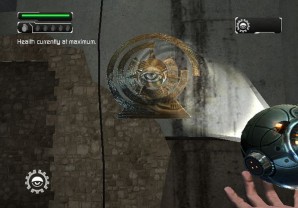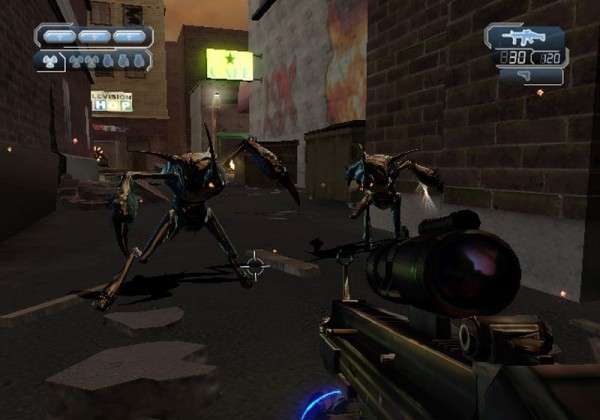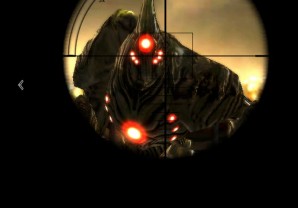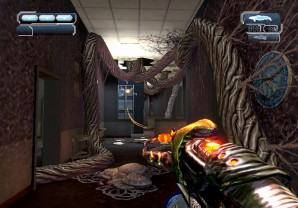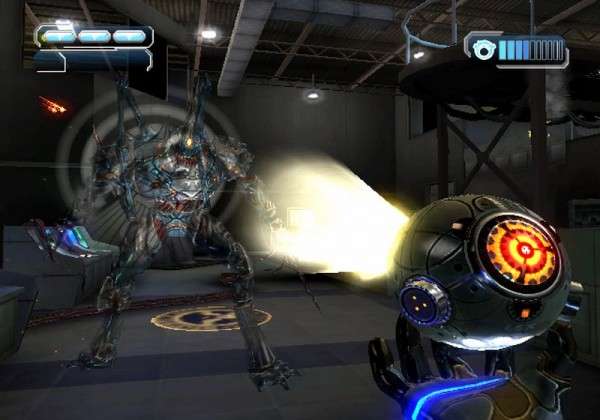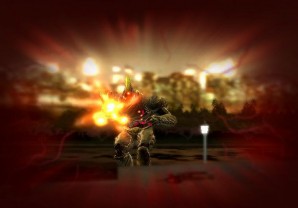
Hands-on: The Conduit Wii
If you haven’t yet heard of The Conduit, then you will soon. This sci-fi FPS intends to raise the bar for controls, graphics, customisation and online play on the Wii, at least according to the developers. It’s a bold claim and I was lucky enough to put this to the test when I tried out The Conduit in both single and multiplayer at SEGA Europe’s HQ.
Picking up the Wiimote and Nunchuk for the first time, I and my fellow journalists were thrown straight into a multiplayer game mid-progress. The controls were fairly intuitive from the get-go, with the Nunchuk being used for movement and the Wiimote for aiming. The B trigger is naturally the shoot button, whilst A jumps and minus reloads. Even the motion controls acted as expected – throwing grenades by lobbing with the Nunchuk and using melee by pushing the Wiimote forwards adds a brilliant sense of physicality to the game. Of course, actually having to point with the Wiimote for aiming already gives you a more tangible connection to the gameplay, and it’s controls like these that make you remember that the Wii does have an advantage over other consoles. It’s just a shame that Wii titles where the controls are a boon rather than a hindrance are exceptions to the rule.
So, in just a couple of minutes we were happily getting down to the business of killing each other. The first full game we played was a Rocket Launchers only free-for-all, which saw eight of us blowing each other to pieces on fairly small map called Streets. It quickly became clear that walking down the central street was suicidal, and making good use of the garages, stairwells and balconies on either side of the map was essential to victory. Your humble DarkZero writer managed to win that match with a twelve kill-streak, but rocket launchers were always a personal favourite of mine. It probably should be noted that a couple of the players were people from SEGA who had prior experience with the game, so it’s clear that even newbies can pick up The Conduit controls easily enough to hold their own against ‘veteran’ players.
The next match was a mode called Three Strikes, which grants each player with just three lives. This mode requires much more caution, as being the last person left alive is extremely beneficial. Before each round, every player can vote on the map, mode and weapon set to be used, with any ties resulting in a random selection by the computer. We chose the Human weapon set, which contained the usual shotguns, assault rifles, sub-machine guns and frag grenades. Nothing new then, but all solidly implemented and satisfying to kill with. The best tactic here seemed to be to try and sneak up behind two other players battling it out and try to nab a cheeky double kill, or finish off a weakened opponent. Through my wily use of stalking and retreating (health regenerates in multiplayer) I remained victorious, but my short-lived winning streak ended here. The Bunker map which we played on was full of corridors and pillars, and ended up being very reminiscent of the design of some of GoldenEye’s multiplayer maps.
Next we went back to the Streets map to try out a mode called ASE Football. ASE stands for All-Seeing Eye, an important device in the single player campaign, which I’ll mention more about later. Basically, this mode is very similar to Oddball on Halo 3. The ASE is placed somewhere on the level, and the aim is to pick it up and hold onto it for as long as possible. The player holding the ASE cannot shoot and their move speed is slowed, but they are still able to melee and throw grenades. ASE Football turned out to be absolute carnage, with all players hunting down whoever held the ASE. Once you pick it up, a swift death is inevitable, so you must do all you can to evade or delay your attackers. We played this mode as a free-for-all, but a team-based version is available, and I feel this would be even more enjoyable. We got to try out the Drudge weapon set too, which is the name of the alien race that appears in The Conduit’s story mode. Here we saw a bit more originality in the weapons, and as well as the expected Plasma Rifle there were also Radiation Grenades, which stick to a surface and drain the health of anyone in the vicinity. There was also a weapon called a Deatomizer which can be charged up for a more powerful shot, and if your Wiimote is tilted on its side, it can be made to fire multiple shots in a spread of different directions. The appearance of Flash Grenades was a godsend for anyone who managed to get hold of the ASE, as blinding your pursuers could gain you a few more valuable seconds towards your score.
Finally, we moved onto a larger, more complex, map which was appropriately named Complex. Here we tried out what is possibly the most interesting and original of The Conduit’s multiplayer modes, Bounty Hunter. Each player is assigned a random player to kill, and successfully killing that target gains you a point. Killing anyone other than your target counts as the murder of an Innocent and you lose a point. Of course, someone else is more than likely chasing you, and two players may be assigned the same target. You are allowed to kill these rival Hunters with no penalties, but of course you have to be watching the movements of other players carefully to determine whether they’re safe to kill or not. The weapon set we had for this match was called Near/Far and was a nice combination of Shotgun and Scoped Rifle. Unfortunately, I was a little too trigger-happy for this mode, and whilst I collected a fair number of Bounties, I killed more than my fair share of Innocents. I look forward to honing my skills further on this game when it’s released in stores.
The multiplayer ran very smoothly with no hint of lag, and although it was running over the proper Regional servers, we can only hope it will maintain such integrity when there are thousands of players online at once. I only spotted one brief glitch where a player was floating in mid-air, but it was made clear that it was not the final build we were playing. Players gain XP after every match, and there are 25 levels to be gained. Levelling up doesn’t grant additional perks like Call of Duty, but is used when matchmaking players of similar ability. Twelve players will be able to participate in the finished game, and although the developers have been forced to use a Friend Code system, you’ll be able to chat to friends of friends over the Wii Speak peripheral should you so choose to.
We were then given the chance to try out the single player campaign, and I used this opportunity to test out how customisable the controls really are. My conclusion? Extensively. Any button or motion can quickly and easily be swapped with any other, and the IR pointer settings can be tweaked to your heart’s desire. I ended up swapping Reload onto the C button and Crouch onto the minus button, as I rarely crouch, but I’m an obsessive compulsive reloader ( I can’t relax if my clip isn’t full.) I swapped the Zoom button to Up on the d-pad, and Quick-180°-turn was then Down on the d-pad as this felt more natural. I swapped Jump from the A button to a Wiimote Motion, and did vice-versa with melee, as I don’t tend to jump much in single player, but I love to punch aliens in the face.
I also reduced the size of the horizontal bounding box, but increased the size of the vertical bounding box, so that I could turn much faster and there would be less chance of me looking at the ceiling or floor by accident. I also discovered that in singleplayer you can adjust your character’s running speed and place HUD elements wherever you like on the screen, but the default settings worked just fine for me. If you really can’t get to grips with turning using the Wiimote, there’s even an option to move turning to the analog stick, so the Wiimote is solely used for aiming, but you would lose the ability to strafe. It’s clear that there will be a control option that works perfectly for everyone in The Conduit.
I must admit that the story didn’t immediately grab me, although the fact that I was playing the game in a noisy room and so missed out on the music and voice acting probably didn’t help. You are cast as Michael Ford, a newly inducted agent to The Trust, who strangely refer to themselves as a ‘clandestine organisation’. Aliens called The Drudge have invaded Washington D.C. and Ford is sent in to try and uncover the reasons behind the attack and to try and stop it. It doesn’t take long for you to find out that factions of the U.S. Government are allied with the Drudge, and that the extraterrestrials appear to be able to control humans to their own ends.
Both the Drudge and human opponents are satisfying to kill, largely thanks to the fantastic variety of motion-captured death animations. The AI seemed fairly clever too, and I witnessed enemies charging in to melee me when I was reloading, and others retreating when they were injured. Your antagonists also seem to make fairly good use of cover, although it wouldn’t be a proper first-person shooter if some of them didn’t choose to stand a little too close to explosive canisters every now and again, would it? The titular Conduits also come into play every so often, with the Drudge using them to deploy more troops. They must be swiftly destroyed to stop the flow of alien scum.
I was able to play through the first three levels of the game, out of a total nine. Although the locations were the unoriginal locations of subway, airport and underground bunker, they were filled with more incidental details than you’d usually expect from a Wii title. Also, any gameplay set on a moving train is always going to get a positive response. It’s a shame that I didn’t get to see any outdoor environments, but I’ve been promised that you do eventually free yourself from the confines of a roof overhead later in the game.
For a Wii game, many parts of The Conduit are graphically outstanding, with a visual fidelity that hasn’t been witnessed on the console before. However, although the textures and modelling of enemies and of your characters hands and weapons were superb, I felt that the textures of the actual environments sometimes felt a bit drab in comparison. Still, this game has undoubtedly pushed the power of the Wii further than ever, with particle and lighting effects that come close to rivalling some Xbox 360 and PS3 titles.
The one feature that attempts to set The Conduit apart from other shooters is the aforementioned All Seeing Eye. This is an orb of presumably Alien origin which allows you to reveal otherwise unseen objects and enemies. The first use for it comes when you encounter a locked door and have to scan the room with the ASE to uncover two hidden switches. These switches are never frustratingly difficult to find, and provide a nice diversion to the usual gameplay that is more entertaining than searching for a key.
The ASE alerts you with a visual and auditory pinging whenever a hidden object is in close proximity, something which becomes a lifesaver when ‘Ghost Mines’ start to pop up. These dangerous obstacles are invisible and must be found and deactivated with the ASE to avoid taking damage. Again, this is a welcome change of pace to the usual frantic shooting of the rest of the game.
The ASE also assists you in finding secret areas that usually contain a special weapon, and can be used to collect translucent data disc collectables that are scattered around the levels. The Conduit also awards the player with 360-style achievements for killing certain numbers of each enemy, getting a particular number of kills with each weapon, and finding all the secrets on each level. Although these are as pointless as Xbox 360 achievements, it’s always nice to have something to work towards.
It’s already clear that The Conduit has been successful in its aims to provide an FPS experience of a quality that hasn’t yet been attempted on the Wii, and it will undoubtedly be one of the top Wii games of 2009. We just hope and pray that the online experience is as robust as it was during our hands-on time.
